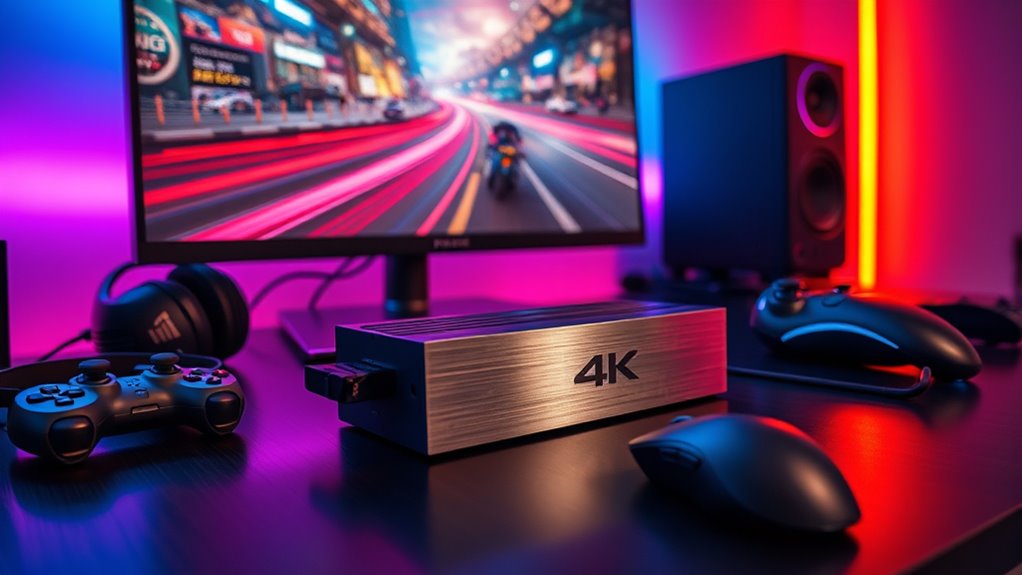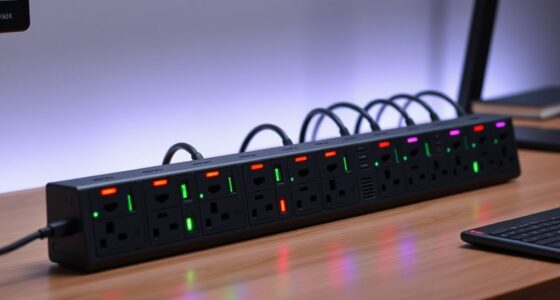If you’re after the best 4K60 streaming capture cards for exceptional gaming in 2025, I recommend checking out options like the Elgato 4K S, HD60 X, and AVerMedia’s high-end models with HDMI 2.1 for ultra-smooth performance. These cards guarantee low latency, stunning visuals, and broad compatibility across devices and platforms. To find the perfect fit for your setup and needs, stay with me — I’ll guide you through the top choices and their features.
Key Takeaways
- Supports 4K60 HDR10 capture and pass-through for high-quality, lag-free gaming and streaming.
- Compatible with multiple devices, including consoles, PCs, Macs, and streaming platforms like Twitch and YouTube.
- Features low latency (under 100ms) with HDMI 2.0/2.1 and USB 3.0/Type-C interfaces for real-time performance.
- Offers portable, plug-and-play setups with no drivers required, suitable for professional and on-the-go streamers.
- Ranges in price from budget-friendly options under $100 to high-end models over $300 with advanced features.
Elgato 4K S External Capture Card for PS5, Xbox Series X/S, Switch 2, PC, Mac, iPad
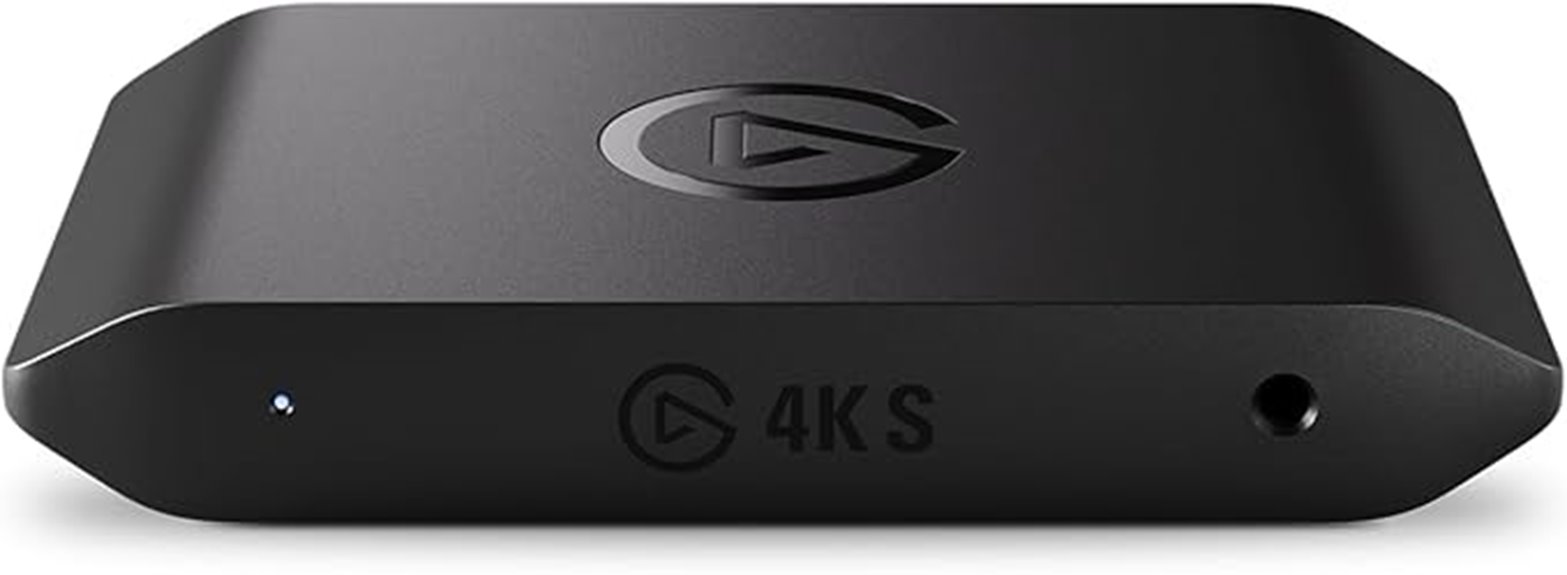
If you’re looking for a versatile and reliable capture card that can handle the latest gaming consoles and computers, the Elgato 4K S External Capture Card is an excellent choice. It records in stunning 4K60 quality, with options for high frame rates like 1440p120 and 1080p240, ensuring smooth gameplay and sharp visuals. HDR10 support adds vibrant color and dynamic tone mapping, perfect for immersive streams. Its USB-C connection guarantees fast, reliable data transfer with near-zero latency. Plus, it works seamlessly across PS5, Xbox Series X/S, Switch 2, PC, Mac, and iPad, making it a flexible tool for any streamer or gamer.
Best For: gamers and streamers seeking a versatile, high-quality capture card compatible with multiple gaming consoles and computers for smooth, cinematic gameplay and streaming experiences.
Pros:
- Supports 4K60 capture with high frame rate options like 1440p120 and 1080p240 for ultra-smooth visuals
- Compatible with a wide range of devices including PS5, Xbox Series X/S, Switch 2, PC, Mac, and iPad
- Features HDR10 and VRR support for enhanced color vibrancy and dynamic refresh rates
Cons:
- May require a powerful PC or Mac to handle 4K60 recording without performance issues
- Limited to external USB-C connections, which may not be compatible with older setups without adapters
- No built-in streaming software, requiring users to use third-party platforms for live streaming
Elgato HD60 X Stream and Record Device
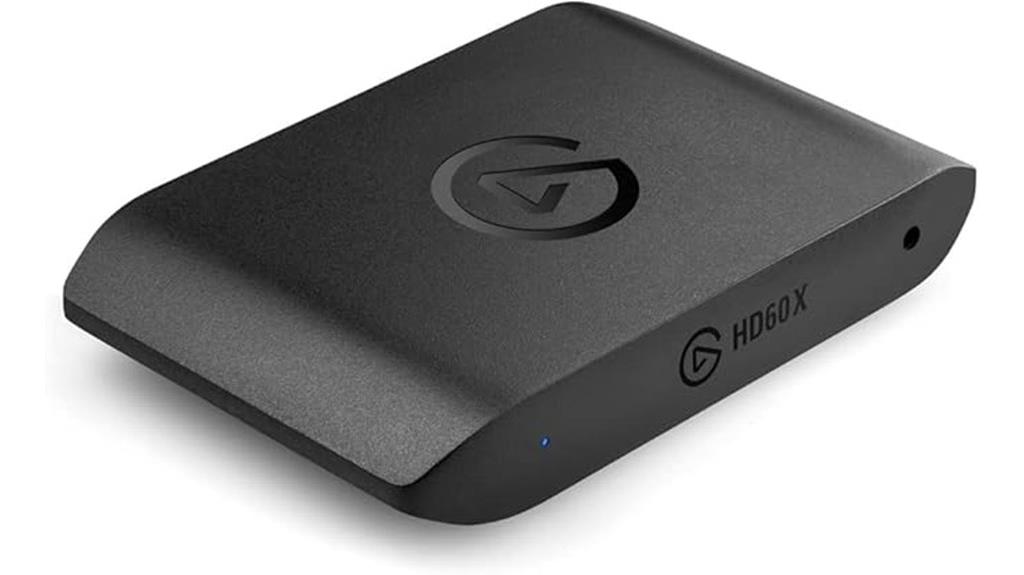
The Elgato HD60 X stands out as an ideal choice for streamers and gamers seeking high-quality, seamless gameplay capture. It supports a wide range of resolutions, including 4K30 HDR10 and 1080p60 HDR10, ensuring stunning clarity. With VRR passthrough, gameplay remains smooth, even during intense moments. Compatibility is broad, working effortlessly with PS5, Xbox Series X/S, Nintendo Switch 2, PC, and Mac, with a driverless setup for quick installation. It offers ultra-low latency below 100ms, perfect for real-time streaming on platforms like Twitch, YouTube, or Zoom. No watermarks, limits, or fees make it a reliable, professional-grade choice.
Best For: streamers, gamers, and content creators seeking high-quality, seamless gameplay capture with broad device compatibility and easy setup.
Pros:
- Supports a wide range of high-resolution formats including 4K30 HDR10 and 1080p60 HDR10 for stunning clarity.
- Ultra-low latency below 100ms ensures real-time streaming and gameplay synchronization.
- Driverless, plug-and-play setup compatible with Windows, Mac, and multiple gaming consoles.
Cons:
- No built-in hardware encoding, which may limit performance for some users.
- Limited to HDR10 support; does not mention HDR10+ or Dolby Vision.
- Requires compatible streaming platform or software for full functionality, which may involve additional setup.
AVerMedia Capture Card for Streaming, 4K60 HDR, 1080p60 Recording, Low Latency for Switch, Xbox, PS5, PC
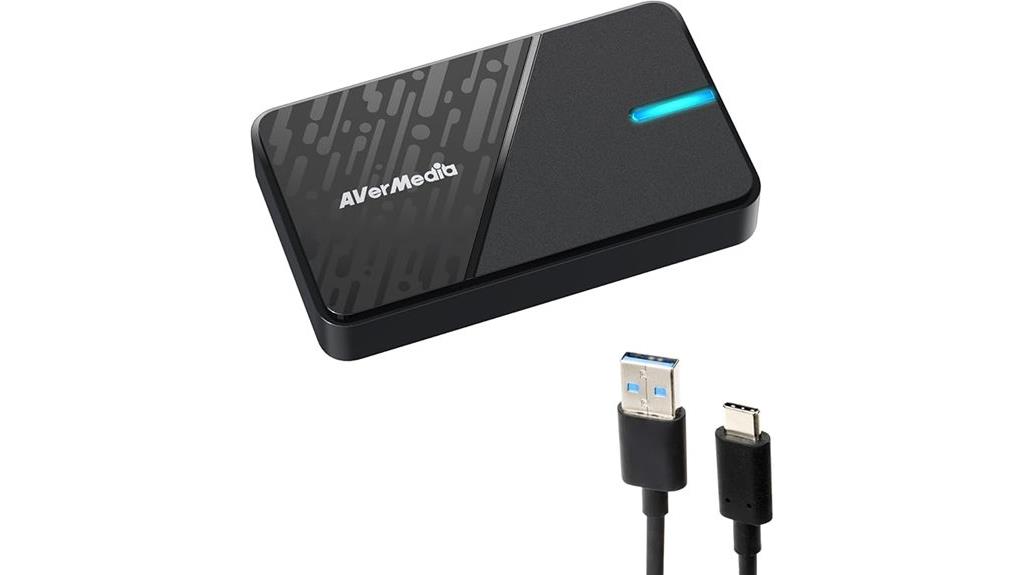
For gamers seeking a reliable and high-quality streaming solution, the AVerMedia Capture Card stands out with its 4K60 HDR pass-through and low latency performance. It supports gameplay in 4K60 HDR on Switch 2, Xbox, and PS5, while recording in smooth 1080p60. Its ultra-low latency guarantees near-instant response, making gameplay seamless. Setup is straightforward—just plug in via USB, with no drivers needed—and it’s compatible with popular streaming software like OBS, Camo Studio, and more. Its compact design makes it portable, perfect for streaming on the go. Overall, it delivers high-quality visuals and smooth performance for serious streamers.
Best For: gamers and streamers seeking high-quality, low-latency gameplay and streaming capabilities across multiple platforms with easy setup and professional-grade features.
Pros:
- Supports 4K60 HDR pass-through and 1080p60 recording for stunning visuals and smooth gameplay
- Ultra-low latency pass-through ensures near-instant response for competitive gaming
- Plug-and-play design with no drivers needed and wide compatibility with streaming software and platforms
Cons:
- May require a powerful PC or console to fully utilize 4K60 HDR features without performance issues
- Limited to 1080p60 recording for local footage, which might be a constraint for some professional editors
- Compact design, while portable, could be less durable for frequent travel or rough handling
Elgato 4K Pro Internal Capture Card for Streaming & Recording
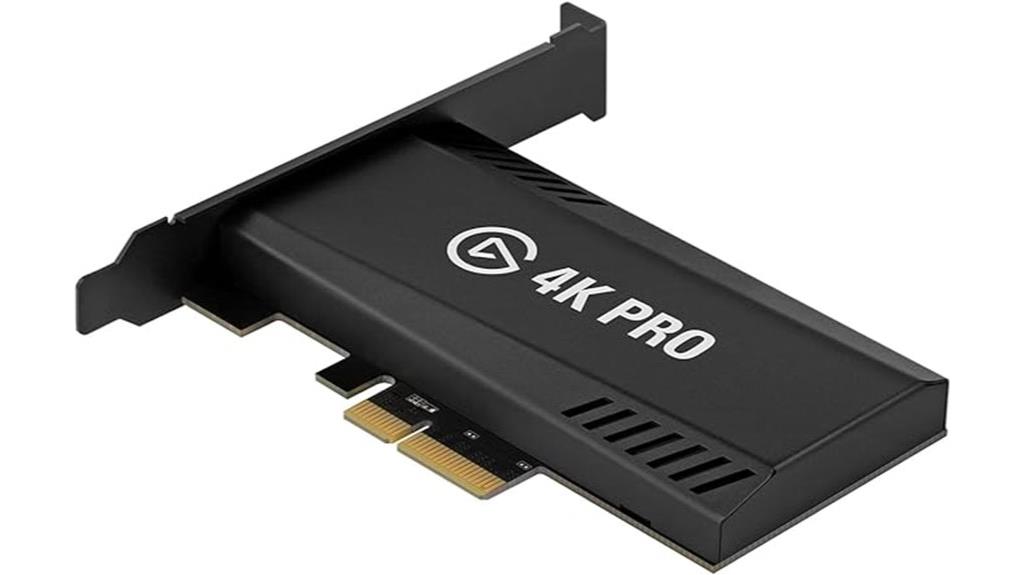
The Elgato 4K Pro Internal Capture Card stands out as the ideal choice for serious streamers and gamers seeking top-tier quality and versatility. It offers 8K60 passthrough, 4K60 HDR10 recording, and true 10-bit HDR support, ensuring stunning visuals. With HDMI 2.1 in/out, it handles high frame rates up to 240fps at 1080p and 4K240 gameplay. Compatible with high-end consoles like PS5 Pro, Xbox Series X/S, and PCs, it supports seamless streaming via popular platforms like Twitch, YouTube, and Discord. Its ultra-low latency and compact design make it perfect for professional setups, delivering immersive, synchronized gameplay and recording without compromise.
Best For: Serious streamers and gamers seeking high-quality, versatile capture capabilities for professional-level gameplay and streaming setups.
Pros:
- Supports 8K60 passthrough and 4K60 HDR10 recording for stunning visuals.
- Ultra-low latency ensures perfectly synchronized gameplay and streaming.
- Compatible with high-end consoles and PCs, including popular streaming platforms.
Cons:
- Requires high-performance hardware and system specifications for optimal operation.
- Compact design may limit upgrade options or additional ports.
- Price point may be higher compared to entry-level capture cards, reflecting its advanced features.
AVerMedia 4K60 Capture Card with HDMI 2.1

If you’re aiming for ultra-smooth gameplay and high-quality streaming, the AVerMedia GC553G2 Live Gamer Ultra 2.1 is an excellent choice thanks to its HDMI 2.1 support, which enables 4K60 capture with HDR and VRR pass-through. It’s compatible with PS5, Xbox Series X/S, Nintendo Switch, Mac, and PC, making it versatile for any setup. The card delivers 4K144 HDR/VRR pass-through for smooth, lag-free gameplay. It also supports seamless audio-video sync, 5.1 channel audio, and direct headset connection for live chat. Its compact design and customizable RGB lighting make it an appealing, high-performance option for serious streamers and gamers alike.
Best For: gamers and streamers seeking high-quality 4K60 gameplay capture with HDR and VRR support across multiple gaming platforms.
Pros:
- Supports 4K144 HDR/VRR pass-through for ultra-smooth gameplay.
- Compatible with a wide range of devices including PS5, Xbox Series X/S, Nintendo Switch, Mac, and PC.
- Features customizable RGB lighting and direct headset connection for seamless chat and stylish setup.
Cons:
- Slightly bulky design despite being compact, which may limit placement options.
- Requires Windows 10/11 x64, potentially excluding older operating systems.
- Rated 4.1/5 stars based on reviews, indicating some users may experience minor issues or limitations.
Capture Card for Nintendo Switch and Streaming Devices
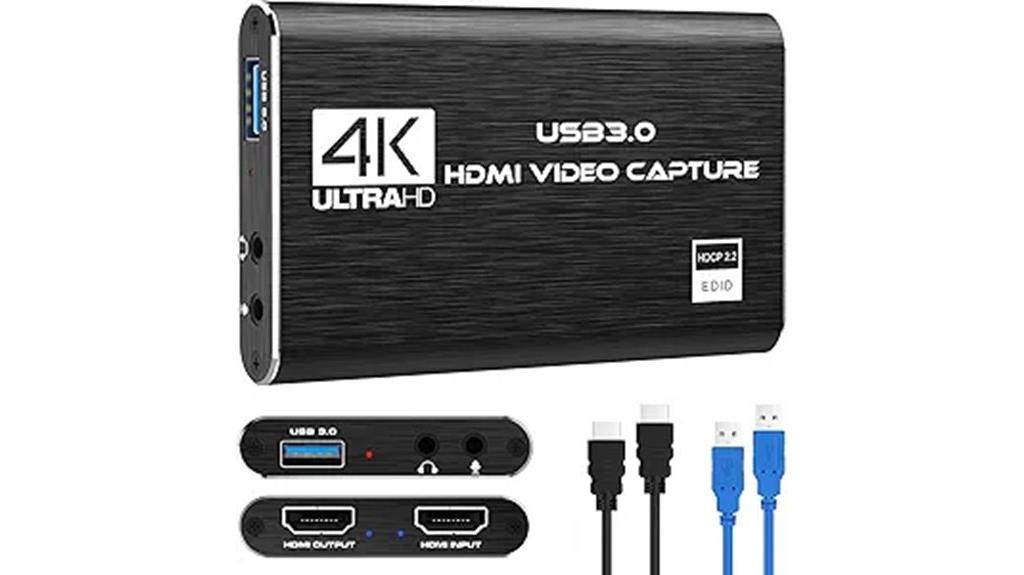
Gamers streaming or recording gameplay from their Nintendo Switch and other HDMI devices will appreciate a capture card that combines high compatibility with effortless setup. This device supports up to 1080p at 60FPS, perfect for capturing Switch gameplay or streaming from consoles like PS4, Xbox, or even cameras. It features HDMI loop-out for real-time play without lag, a microphone input for commentary, and a plug-and-play design that requires no drivers. Compatible with Windows, Mac, and popular streaming platforms like OBS, Twitch, and YouTube, it uses USB 3.0 for low latency. Compact and lightweight, it’s an excellent choice for seamless, high-quality streaming.
AVerMedia HDMI 2.1 PCIe Capture Card for 4K60 Streaming
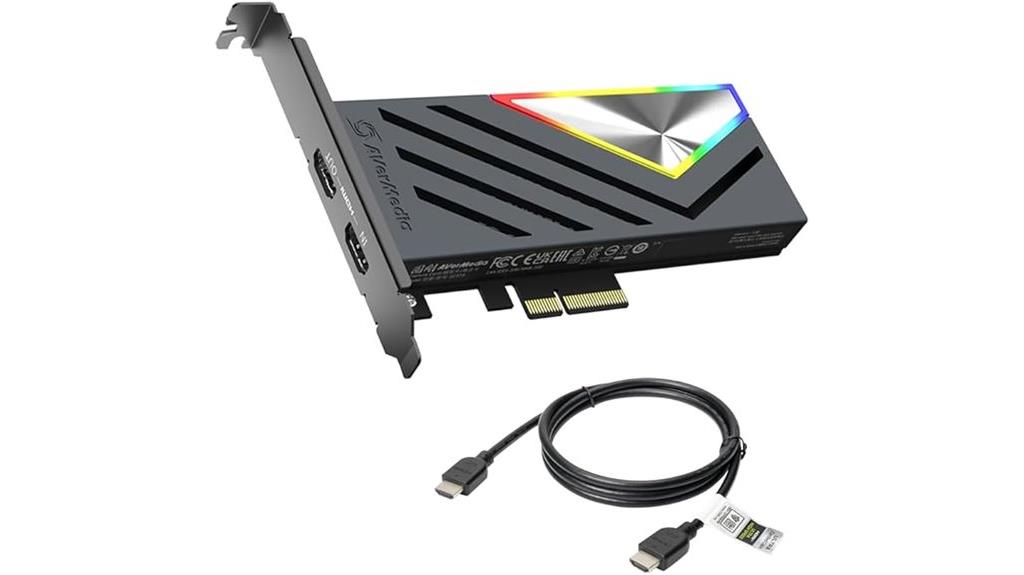
For those seeking a professional-grade streaming solution, the AVerMedia HDMI 2.1 PCIe Capture Card stands out with its support for HDMI 2.1, enabling seamless 4K60 recording and streaming. Its ultra-low latency performance guarantees smooth gameplay capture, making it ideal for serious gamers and content creators. Compatible with consoles like PS5, Xbox Series X/S, and Nintendo Switch, it offers future-proof connectivity with HDMI 2.1 compliance. The internal PCIe interface provides a stable, high-speed data transfer, delivering high-quality visuals without compromise. Overall, this capture card combines professional features with ease of use, elevating your gaming and streaming experience to new heights.
Best For: professional gamers, streamers, and content creators seeking high-quality 4K60 capture with future-proof connectivity and ultra-low latency performance.
Pros:
- Supports HDMI 2.1 for seamless 4K60 recording and streaming
- Ultra-low latency performance ensures smooth gameplay capture
- Compatible with major gaming consoles like PS5, Xbox Series X/S, and Nintendo Switch
Cons:
- Requires a PCIe slot and compatible PC setup, which may not suit all users
- Premium price point compared to basic capture cards
- May need additional software configuration for optimal use
AVerMedia GC573 Live Gamer 4K Internal Capture Card

The AVerMedia GC573 Live Gamer 4K Internal Capture Card stands out as a top choice for serious streamers and content creators who demand stunning visuals and smooth performance. It supports 4K60 resolution with HDR10 pass-through, ensuring crisp, vibrant gameplay for streaming and recording on PS5, Xbox Series X/S, and PC. With high frame rate passthrough—240Hz at 1080p and 120Hz at 1440p—it guarantees ultra-smooth motion for competitive gaming. Its plug-and-play design requires no drivers or external power, fitting easily into PCIe slots. Plus, it offers ultra-low latency, making live reactions, tutorials, and gameplay seamless and reliable.
Best For: serious streamers and content creators seeking high-quality 4K gameplay capture with ultra-smooth performance and seamless streaming capabilities.
Pros:
- Supports 4K60 HDR10 pass-through for vibrant, crisp visuals during gameplay and streaming
- Offers high frame rate passthrough: 240Hz at 1080p and 120Hz at 1440p, ideal for competitive gaming
- Plug-and-play design requiring no drivers or external power, ensuring easy installation and compatibility
Cons:
- Internal PCIe installation may not be suitable for users unfamiliar with PC hardware setup
- Premium price point compared to basic capture solutions
- Limited to PC and compatible consoles, not designed for external or portable use
AVerMedia 4K HDMI Capture Card for Streaming and Recording
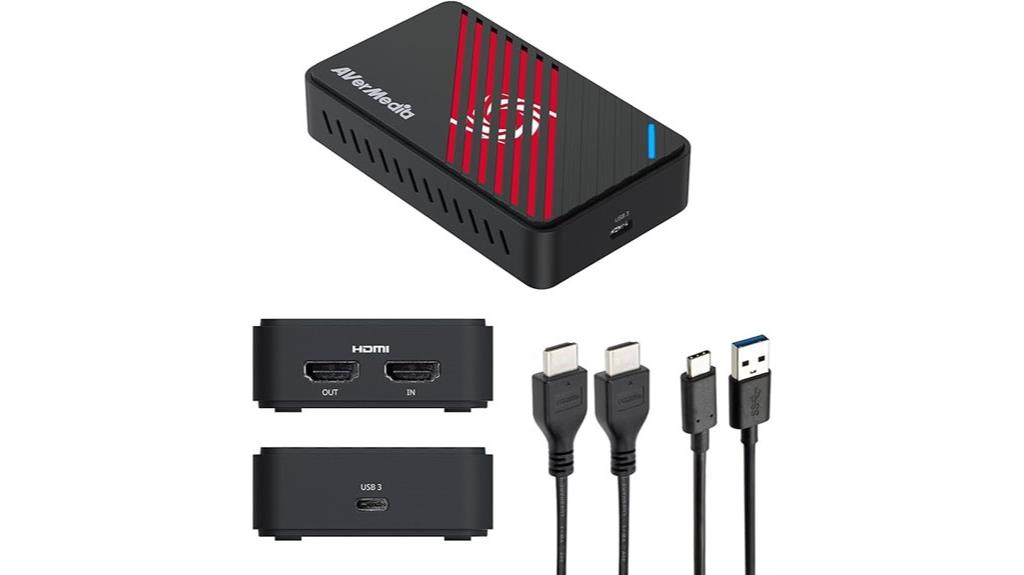
If you’re seeking a high-performance capture card that delivers stunning 4K60 HDR visuals with minimal delay, the AVerMedia GC553Pro is an excellent choice. It supports gameplay from PS5, Xbox Series X/S, Nintendo Switch 2, and PC, offering smooth 4K60 HDR and VRR pass-through. Compatible with Windows, MacOS, and iPadOS, it allows streaming on platforms like Twitch, YouTube, and OBS Studio. Its plug-and-play setup requires no extra drivers, ensuring quick deployment. With ultra-wide resolutions and true RGB colors, it guarantees high-quality, uncompressed video. Weighing just under 15 ounces, it’s a versatile, easy-to-use option for gamers and streamers seeking professional-grade performance.
Best For: gamers and content creators seeking high-resolution, low-latency streaming and recording across multiple platforms with professional-grade visuals.
Pros:
- Supports 4K60 HDR and VRR pass-through for smooth, high-quality gameplay visuals
- Plug-and-play setup compatible with Windows, MacOS, and iPadOS without needing extra drivers
- Ultra-wide resolutions and true RGB colors ensure vibrant, uncompressed video quality
Cons:
- Slightly heavier at 14.8 ounces, which may be less portable for on-the-go use
- Limited details on included accessories or bundled software options
- Higher price point compared to basic capture cards without 4K HDR support
4K60 HDMI Capture Card for Streaming and Recording
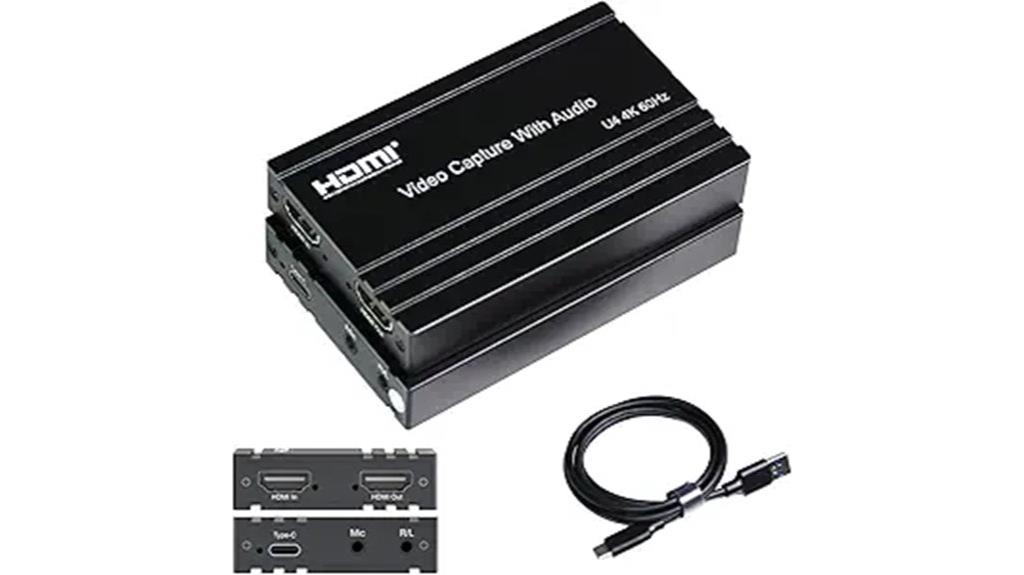
Looking for a capture card that delivers professional-grade 4K60 streaming and recording without hassle? The K60 HDMI Capture Card supports input/output up to 4K@60Hz, with HDR10 passthrough and 4K HDMI loop-out for smooth performance. It’s compatible with Windows, MacOS, OBS, and other popular streaming software. Equipped with HDMI 2.0 ports, a Type-C USB, microphone input, and stereo audio output, it offers versatile connectivity. Its plug-and-play design means no drivers or extra power are needed, ensuring zero-latency pass-through and stunning visuals. Perfect for gamers, streamers, or content creators seeking reliable, high-quality capture in a compact, user-friendly package.
Best For: streamers, gamers, and content creators seeking high-quality 4K60 recording and streaming with easy setup and reliable performance.
Pros:
- Supports 4K@60Hz input/output with HDR10 passthrough for vibrant visuals
- Plug-and-play design requiring no drivers or additional power
- Compatible with Windows, MacOS, OBS, VLC, and more for versatile use
Cons:
- Limited to HDMI 2.0 ports, which may not support older devices
- Slightly higher price point compared to lower-resolution capture cards
- May require additional software configuration for optimal performance
AVerMedia Live Gamer Ultra 2.1 HDMI 2.1 Capture Card

Gamers and streamers seeking professional-grade quality will find the AVerMedia Live Gamer Ultra 2.1 HDMI 2.1 Capture Card to be an excellent choice, thanks to its support for true 4K60 HDR10 capture with HDMI 2.1 pass-through. It’s compatible with next-gen consoles like PS5, Xbox Series X|S, and Nintendo Switch 2, as well as PCs and Macs. The plug-and-play design with Type-C connectivity ensures quick setup without external power or drivers. It offers near-zero-lag, high-fidelity streaming with support for HDMI 2.1 features like VRR, giving you smooth gameplay, vivid colors, and immersive audio for professional-quality streams.
Best For: gamers and streamers seeking professional-grade 4K HDR60 capture with seamless HDMI 2.1 pass-through for next-gen consoles and high-fidelity PC streaming.
Pros:
- Supports true 4K60 HDR10 capture with vivid colors and detailed visuals
- Near-zero-lag, high-fidelity streaming ideal for competitive gaming and live commentary
- Plug-and-play design with Type-C connectivity, no external power or drivers needed
Cons:
- Limited information on bundled software features and customization options
- Weighs 4.1 ounces, which might be slightly bulky for portable setups
- Customer reviews indicate a need for ongoing software updates to optimize performance
NearStream 4K HDMI Capture Card for Streaming and Recording

The NearStream 4K HDMI Capture Card stands out as an excellent choice for content creators and streamers seeking high-quality, low-latency video capture. It supports HDMI input/output up to 4K@60fps, while still being backward compatible for streaming and recording at lower resolutions. I appreciate its plug-and-play design, which works seamlessly across Windows, Mac, and Linux without needing drivers. With a built-in 3.5mm audio interface, I can easily connect headsets or microphones for voice chat. Its compact size and compatibility with major streaming platforms make it an ideal tool for gamers, YouTubers, and professionals aiming for crisp, real-time streaming and recording.
Best For: content creators, streamers, and gamers seeking high-quality, low-latency HDMI video capture for streaming, recording, and video conferencing.
Pros:
- Supports HDMI input/output up to 4K@60fps for high-resolution streaming and recording.
- Plug-and-play design ensures easy setup across Windows, Mac, and Linux without drivers.
- Built-in 3.5mm audio interface allows seamless connection of microphones or headsets for voice communication.
Cons:
- Limited to 1080P at 60fps recording via USB 3.0, which may not meet all 4K recording needs.
- Compact size might make it less durable for heavy travel or rough handling.
- Compatibility with some older or less common streaming platforms may require additional configuration.
AVerMedia HDMI Capture Card for Streaming and Gaming
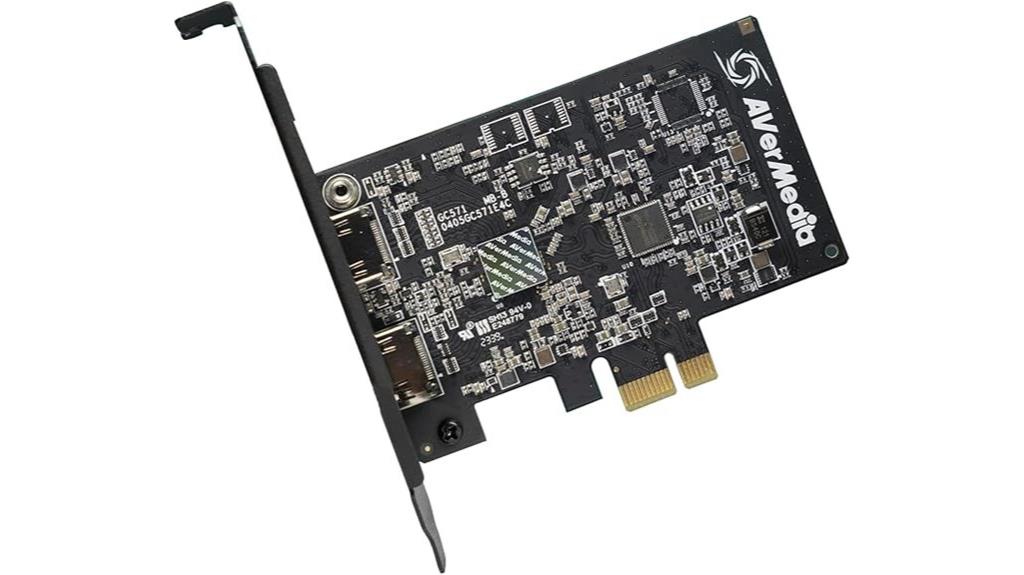
If you want a reliable capture card that effortlessly integrates with various gaming setups, the AVerMedia GC571 is an excellent choice. It supports HDMI 2.0 input with 4K60 pass-through, allowing smooth gameplay while streaming in 4K30. Compatible with PCIe x1, x4, x8, and x16 slots, it works with most systems without fuss—no drivers needed. Key features include VRR for tear-free gaming, 1080p120FPS high frame rate recording, and ultra-low latency for real-time streaming. Compact and easy to set up, it offers excellent performance for live streamers and gamers seeking high-quality visuals with minimal hassle.
Best For: streamers and gamers seeking high-quality, easy-to-use HDMI capture for seamless gameplay and streaming in 4K or 1080p at high frame rates.
Pros:
- Supports HDMI 2.0 with 4K60 pass-through for smooth gameplay and high-quality streaming
- Compatible with a wide range of PCIe slots and systems, requiring no drivers for setup
- Features VRR technology and ultra-low latency for an enhanced gaming experience
Cons:
- Slightly larger dimensions may require adequate space in setup area
- Limited to HDMI input; does not support other video interfaces
- May be more expensive compared to basic capture cards lacking advanced features
AVerMedia 4K60 HDMI Capture Card for Live Streaming and Video Conferencing
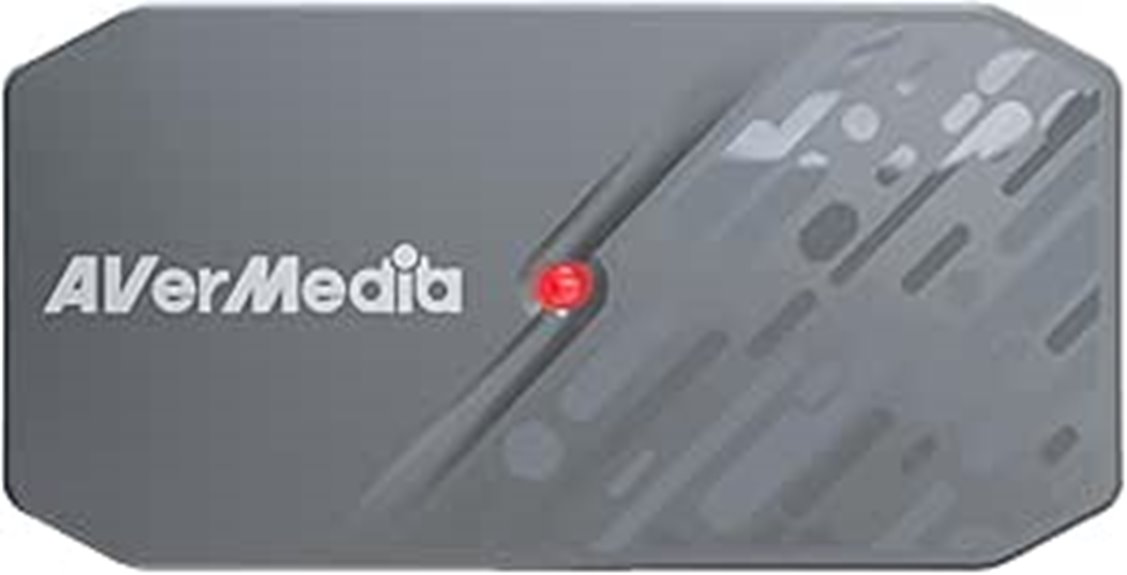
For content creators and professionals who need reliable, high-quality streaming and video conferencing solutions, the AVerMedia CamStream 4K BU113G2 stands out with its true 4K60 capture capability and ultra-low latency performance. It seamlessly connects to cameras like DSLRs, camcorders, action cameras, and GoPros via HDMI, supporting popular platforms such as OBS, Zoom, and Twitch. The plug-and-play design requires no drivers, making setup quick and easy, while its high-fidelity audio and lag-free streaming ensure professional results. Compact and portable, it’s perfect for live broadcasts, webinars, or real-time video calls, delivering smooth, high-quality content every time.
Best For: content creators, streamers, and professionals seeking high-quality 4K60 HDMI capture for live streaming, video conferencing, and professional broadcasts.
Pros:
- Supports true 4K60 resolution with ultra-low latency for lag-free streaming.
- Plug-and-play design with no driver installation needed, ensuring quick setup.
- Compatible with multiple platforms including OBS, Zoom, Twitch, and more, across Windows, macOS, iPadOS, and Android.
Cons:
- Limited to HDMI input; cannot capture from non-HDMI sources without adapters.
- Slightly larger and heavier compared to ultra-compact capture devices.
- No onboard recording; requires an external device or software for saving content.
AVMATRIX HDMI 2.0 to USB3.1 Capture Card for Streaming and Gaming

When seeking a capture card that delivers professional-grade 4K60Hz HDR video with ultra-low latency, the AVMATRIX HDMI 2.0 to USB3.1 Capture Card stands out as an excellent choice. It supports high-quality multi-platform gaming on devices like PS5, Xbox Series X/S, PC, and Mac, with uncompressed RGB24 color for richer visuals. Its plug-and-play design requires no additional drivers or power, making setup quick and easy. With flawless 4K60Hz passthrough, synchronized audio, and support for background removal, it’s perfect for live streaming, content creation, and professional broadcasts. Plus, a 2-year warranty and lifetime support ensure reliable, hassle-free performance.
Best For: streamers, gamers, and content creators seeking high-quality 4K HDR video capture with ultra-low latency across multiple platforms.
Pros:
- Supports 4K60Hz HDR passthrough with VRR and uncompressed RGB24 color for vibrant visuals.
- Plug-and-play design requires no drivers or additional power, ensuring easy setup.
- Compatible with Windows, Mac, and iPadOS 17+ for versatile device integration.
Cons:
- Limited to HDMI 2.0 specifications; may not support older HDMI devices.
- Potential compatibility issues with certain streaming software or hardware configurations.
- Does not include additional accessories like HDMI cables or external power adapters.
Factors to Consider When Choosing 4K60 Streaming Capture Cards

When selecting a 4K60 streaming capture card, I focus on key factors like compatibility with my devices, resolution quality, and performance. I also consider connectivity options and how user-friendly the software is to guarantee smooth streaming. Knowing these aspects helps me choose a card that meets my gaming and streaming needs efficiently.
Compatibility With Devices
Choosing the right 4K60 streaming capture card depends heavily on ensuring it’s compatible with your devices. First, check that it supports your operating system—whether Windows, macOS, Linux, or iPadOS—to avoid headaches during setup. If you’re using gaming consoles like PS5, Xbox Series X/S, or Nintendo Switch, confirm that the capture card connects seamlessly with them. Compatibility with your device’s input/output ports, such as HDMI 2.0 or HDMI 2.1, is vital for maintaining 4K60 performance. Also, decide if you prefer a plug-and-play card or one that needs drivers, as this impacts setup ease. Finally, verify that the capture card can handle your device’s resolution and refresh rate, like 4K60 HDR or 1440p120, for the best streaming experience.
Resolution and Frame Rate
To achieve crisp, smooth gameplay captures, it’s essential that your capture card supports 4K resolution at a minimum of 60 frames per second (4K60). This ensures your streams are sharp and fluid, capturing every detail of your gaming experience. Look for options offering higher frame rates like 1440p120 or 1080p240 for even smoother gameplay. Supporting HDR10 or HDR passthrough is also beneficial, as it preserves vibrant colors and contrast in your streams. Always verify that the maximum resolution and frame rate are compatible with your console or PC hardware to avoid limitations. Additionally, consider whether the device supports variable refresh rate (VRR) pass-through, which helps prevent screen tearing during gameplay, ensuring a seamless viewing experience.
Latency and Performance
Low latency is essential for maintaining a smooth, responsive streaming experience, especially during fast-paced gameplay. Ideally, latency should stay below 100ms to guarantee real-time feedback. High-performance capture cards support HDMI 2.1 or HDMI 2.0 standards, which help minimize delay during data transfer. Hardware encoding and optimized data pipelines further reduce processing latency, enhancing overall responsiveness. However, latency can be affected by factors like connection type, cable quality, and your system’s hardware, so these must be carefully considered. Real-world testing and user reviews are invaluable for evaluating whether a capture card maintains low latency under typical streaming workloads. Prioritizing these factors helps ensure your gameplay remains seamless and your stream responsive.
Connectivity Options
When selecting a 4K60 streaming capture card, ensuring it has the right connectivity options is essential for seamless performance. I look for support for HDMI 2.0 or 2.1, which are vital for high-resolution data transfer without lag. Fast data transmission relies on USB-C or USB 3.0/3.1/3.2 ports, so I check that these are available for reliable, low-latency streaming. HDMI pass-through or loop-out options are a must, as they allow me to play in real-time without interruption. Compatibility with my computer’s or console’s connection type—be it PCIe, USB, or external HDMI input—is also critical. Additionally, I consider whether the capture card supports extra audio input/output options like 3.5mm jacks for integrated audio management during streams.
Software Compatibility & Ease
Choosing a 4K60 streaming capture card that offers excellent software compatibility makes a real difference in my streaming setup. I look for devices that seamlessly work with popular platforms like OBS, Streamlabs, or XSplit, so I can switch between them effortlessly. Compatibility with my operating system—Windows, macOS, or Linux—is essential to avoid driver hassles. I prefer plug-and-play models that require no extra drivers or complex setup, saving time and frustration. Customizable software settings are also *indispensable*; they let me fine-tune encoding, resolution, and audio sync for the best quality. Finally, I check if the device receives firmware updates and ongoing software support, ensuring it stays compatible with evolving streaming platforms and features. This focus helps me maintain a smooth, reliable streaming experience.
Price and Budget
Budget is a key factor that directly impacts the features and performance I can get in a 4K60 streaming capture card. Prices range from under $100 for basic models to over $300 for premium options with advanced features. My budget often guides my choice, as it influences essential aspects like HDR support, low latency, and device compatibility. Investing in a higher-end card can offer better video quality, durability, and future-proofing, especially with HDMI 2.1 or PCIe support. I also look for promotions, discounts, and bundle deals to maximize value. Ultimately, I aim to balance my budget with must-have features, ensuring my capture card delivers the streaming quality I need without overspending. This approach helps me get the best performance within my financial limits.
Frequently Asked Questions
How Do I Optimize Latency Settings on These Capture Cards?
To optimize latency settings on your capture card, I recommend enabling any low-latency or game mode options in the software. Make sure your USB or PCIe connection is secure and use high-quality cables. Adjust your streaming software’s buffer size—lower it for less delay but be cautious of potential stuttering. Keep your drivers updated, and close background apps to reduce overall system latency. This helps guarantee smooth, real-time gameplay.
Are There Compatibility Issues With Certain Streaming Software?
Yes, compatibility issues can arise with certain streaming software. I’ve noticed some capture cards work better with OBS or Streamlabs, while others might have driver conflicts or limited support for specific platforms. To avoid problems, I always check the card’s compatibility list and verify my software is up to date. Testing before a live stream helps me troubleshoot any issues early, ensuring smooth, high-quality broadcasts every time.
What Are the Maintenance and Longevity Tips for 4K60 Capture Cards?
Coincidentally, maintaining my 4K60 capture card keeps it performing like new. I always keep it dust-free, store it in a cool, dry place, and avoid unplugging it suddenly. Regularly updating its firmware helps prevent glitches and extends its lifespan. I also handle it gently, avoiding bending or dropping. Following these simple tips guarantees my capture card stays reliable, delivering high-quality streams for years to come.
Can These Cards Support Future Gaming Consoles Beyond 2025?
Yes, many 4K60 capture cards are designed with future-proofing in mind, supporting upcoming gaming consoles beyond 2025. I always look for models with versatile HDMI inputs and updated firmware to guarantee compatibility. While technology evolves rapidly, investing in a high-quality, reputable capture card helps me stay ready for new consoles and features. Just keep an eye on manufacturer updates and specifications to maximize longevity and compatibility.
How Do I Troubleshoot Common Signal or Connection Problems?
When troubleshooting signal or connection issues, I always start by checking the cables first—loose or damaged ones are often the culprit. Then I verify the input and output settings on both my device and the capture card, making sure they match. If problems persist, I restart my devices and update drivers. Sometimes, switching ports or resetting my settings fixes the glitch, keeping my gameplay smooth and uninterrupted.
Conclusion
Choosing the right 4K60 capture card is like finding the key to a seamless gaming experience—it’s the bridge between your gameplay and viewers. With options from top brands like Elgato and AVerMedia, you’ll gain access to stunning visuals and low latency. Remember, as with any great tool, it’s about matching the card to your needs. So go ahead, make your setup legendary, and let your gameplay shine brighter than the stars of a new dawn.
